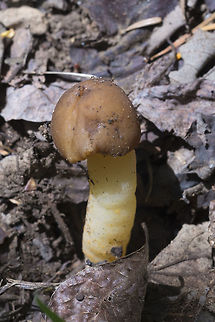
Appearance
Fruiting bodies have a smooth cap that is bell-shaped or conical, and 1.5 to 4 cm broad; it is attached to the top of the stem only, the margin of the cap is free – hanging like a skirt. The underside of the cap is tan to dark brown in color. The stem, which measures 5 to 11 cm by 1 to 1.5 cm thick, is white and tapers upwards so that the apex is slightly thicker than the base; the stem surface is either smooth or slightly fuzzy. It is generally hollow, although young specimens may be filled with cotton-like hyphae. The flesh is thin and brittle, and the cap can be easily broken off the stem.David Arora notes that sometimes a variety with a wrinkled cap can be found, somewhat resembling a ''Gyromitra''.
Distribution
This species grows singly, scattered, or in groups on the ground in both hardwood and coniferous forests, often in river valleys, or along stream banks. It often fruits in late spring, usually near morel season. It has been reported to fruit abundantly in the chaparral scrubland in southern California.Habitat
This species grows singly, scattered, or in groups on the ground in both hardwood and coniferous forests, often in river valleys, or along stream banks. It often fruits in late spring, usually near morel season. It has been reported to fruit abundantly in the chaparral scrubland in southern California.References:
Some text fragments are auto parsed from Wikipedia.